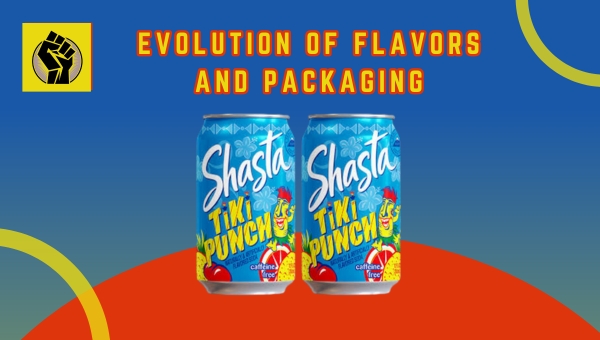Imagine it’s a hot summer afternoon. You’re on the porch with friends, and someone hands you an ice-cold can of Shasta Drink. Instantly, you’re transported back to simpler times, as the iconic fizz and flavor remind you of countless family picnics and gatherings.
Since its humble beginnings at the base of Mount Shasta in 1889, this drink has evolved remarkably, capturing the hearts of generations. Shasta Drink isn’t just a refreshment; it’s a testament to innovation and cultural significance. Dive into the journey of this beloved beverage, exploring its origins and the impact it’s had on the industry and popular culture.
Origins of Shasta Drink
The story of Shasta Drink begins in 1889 with the establishment of the Shasta Mineral Springs Company, nestled at the base of Mount Shasta in California. Initially, the company was dedicated to bottling mineral water sourced from natural springs, which are known for their refreshing quality.

In 1931, Shasta expanded its horizons by venturing into the soft drink industry with the introduction of its first product, a ginger ale. The 1950s marked a period of innovation for Shasta, as it began to offer soft drinks in cans and introduced low-calorie options to cater to a broader market.
This evolution helped transition Shasta from primarily being a mineral water provider to a recognized soda brand. With its acquisition by National Beverage Corp. in 1985, Shasta solidified its position in the beverage industry, continuing its commitment to quality and variety.
Evolution of Flavors and Packaging
Shasta Drink has consistently evolved to meet the changing preferences of its consumers. The brand has been proactive in introducing a variety of flavors and packaging options, which has played a significant role in maintaining its appeal.

The following sections will delve into how Shasta has expanded its flavor offerings and innovated its packaging to stay competitive.
Introduction of New Flavors
Over the years, Shasta has broadened its flavor selection to attract a wide range of taste preferences. Initially focusing on classic flavors, the brand gradually introduced unique and seasonal variations. This expansion has not only kept loyal customers engaged but has also drawn in new consumers.
By offering a diverse array of flavors, Shasta has ensured that there’s something for everyone, fostering a connection with a broader market.
Innovations in Packaging
Shasta’s packaging innovations have been pivotal in maintaining its relevance in the beverage industry. The brand has embraced recyclable materials and introduced designs that catch the eye of consumers.
These changes have not only enhanced the convenience and appeal of their products but have also distinguished Shasta from its competitors. By continuously updating its packaging, Shasta has managed to keep pace with market trends and consumer expectations.
Also Read: Brad’s Drink Pepsi | The Refreshing Revolution
Shasta Drink’s Impact on the Beverage Industry
Shasta Drink has carved a unique niche in the beverage industry through innovative strategies and engaging collaborations. Its impact is multifaceted, influencing both marketing trends and brand partnerships.
This has helped Shasta reach a wider audience and maintain its presence in a highly competitive market. Let’s dive into the marketing strategies and collaborations that have propelled Shasta’s success.
Marketing Strategies
Shasta has utilized various marketing strategies to enhance its visibility and boost sales. Here are some key approaches:
- Creative Advertising Campaigns: Shasta has crafted ads that target diverse demographics, ensuring wide appeal.
- Value-Driven Promotions: By emphasizing value and variety, Shasta attracts and retains customers.
- Social Media Engagement: Active engagement with consumers through social platforms keeps the brand relevant and accessible.
Collaborations and Partnerships
Collaborations and partnerships have significantly boosted Shasta’s market presence. Here’s how:
- Retail Collaborations: Partnering with retailers for exclusive flavor launches has expanded Shasta’s reach.
- Event Partnerships: Collaborating with events to promote the brand increases visibility.
- Influencer Engagements: Working with influencers helps Shasta tap into broader audiences, enhancing brand recognition.
Challenges and Controversies
Shasta has faced various challenges and controversies throughout its history, impacting its reputation and market strategies.

Health concerns surrounding sugary beverages have prompted Shasta to adapt its product offerings, while competition in the soft drink market has driven the brand to innovate and evolve continuously. These factors have shaped Shasta’s approach to maintaining relevance in a rapidly changing industry.
Health Concerns
Over the years, Shasta drinks have been scrutinized for their sugar content and artificial ingredients.
Key health concerns include:
- High Sugar Content: Many Shasta sodas contain significant amounts of sugar, contributing to obesity and other health issues. This has led to increased consumer awareness and demand for healthier options.
- Artificial Ingredients: Some consumers express concerns over artificial flavors and preservatives used in Shasta products. This has prompted the brand to explore cleaner formulations.
- Diet Variants: In response to health trends, Shasta has introduced diet versions of its drinks, utilizing artificial sweeteners like aspartame and sucralose. However, these alternatives have also faced criticism regarding their safety and potential health effects.
- Recent Innovations: To address these concerns, Shasta launched its Soft-Drink Alternative (SDA), which features all-natural ingredients with no calories or sweeteners, reflecting a shift towards healthier beverage options.
Competition in the Market
The competitive landscape of the beverage industry has significantly influenced Shasta’s strategies and offerings.
Key aspects include:
- Emerging Health Trends: As consumers increasingly seek healthier beverages, Shasta has adapted by introducing low-calorie options and reformulating existing products to reduce sugar content.
- Innovative Flavors: To stay relevant, Shasta continuously develops new flavors that cater to shifting consumer preferences. This includes experimenting with unique combinations and seasonal offerings.
- Marketing Strategies: Shasta employs aggressive marketing tactics to differentiate itself from competitors. This includes leveraging social media campaigns and partnerships with influencers to engage younger audiences.
- Pricing Strategies: The brand utilizes competitive pricing to attract cost-conscious consumers while ensuring profitability. This strategy helps maintain market share against larger beverage companies.
- Collaborations: Strategic partnerships with retailers and participation in events have bolstered Shasta’s visibility in a crowded market, allowing it to reach broader audiences effectively.
These challenges and competitive pressures have compelled Shasta to innovate continually while navigating the complexities of consumer health consciousness and market dynamics.
Also Read: Exploring RC Soft Drinks: History and Varieties
Shasta Drink’s Legacy and Cultural Influence
Shasta Drink has carved a niche in the beverage industry not only through its diverse flavors but also via its cultural footprint. It’s fascinating how a drink can embed itself so deeply in our collective consciousness. From its inception, Shasta has been more than just a beverage; it’s a symbol of a bygone era that still finds relevance today.
Pop Culture References
Shasta has made its mark in pop culture, often appearing in movies and TV shows that evoke a sense of nostalgia. These appearances have not only kept the brand in the public eye but have also highlighted its timeless appeal.
Whether in a scene featuring a family gathering or a retro-themed party, Shasta often symbolizes a piece of Americana, resonating with audiences across generations.
Shasta Drink in Modern Times
Today, Shasta continues to hold its ground by adapting to changing consumer preferences while honoring its rich history. The brand’s ability to introduce new flavors and maintain classic ones ensures it remains a household name.
Through engaging marketing and a commitment to quality, Shasta stays relevant, appealing to both long-time fans and new consumers who appreciate its unique blend of tradition and innovation.
FAQs
Where is Shasta Soda sold?
Shasta soda is widely available in the United States. You can find it in supermarkets, convenience stores, and online retailers that offer a variety of flavors and packaging options.
Who owns Shasta?
Shasta is owned by National Beverage Corp. This company acquired Shasta in 1985, enhancing its presence in the beverage industry with a diverse range of products.
When was Shasta Soda Launched?
Shasta soda was first introduced in 1931. It started as a ginger ale and has since expanded its product line to include a wide array of flavors to suit different tastes.
Conclusion
Shasta Drink has successfully navigated the ever-changing landscape of the beverage industry. From its humble beginnings as a mineral water company to becoming a household name with a diverse range of flavors, Shasta has shown resilience and adaptability.
Despite facing challenges and competition, the brand has maintained its cultural significance through strategic marketing, innovative packaging, and a commitment to quality. Shasta’s legacy is not only a testament to its enduring popularity but also its ability to resonate with consumers across generations.
Be sure to explore more insightful articles on our site to uncover the stories behind other iconic brands!





